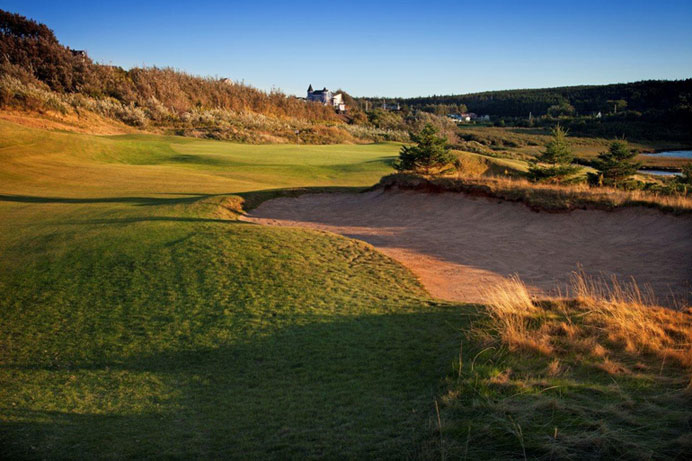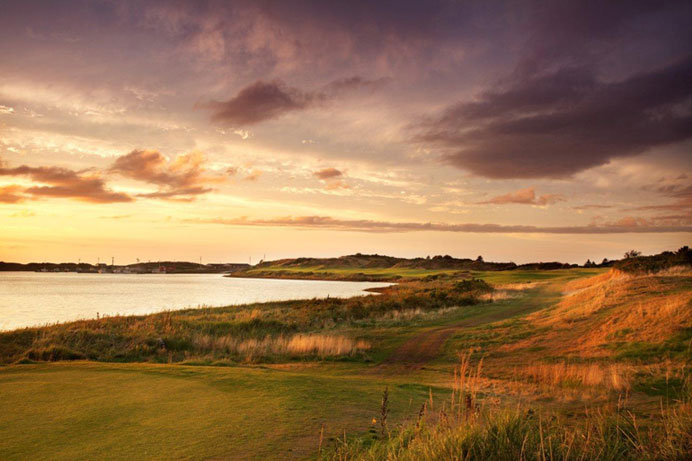Cabot Links
Nova Scotia, Canada
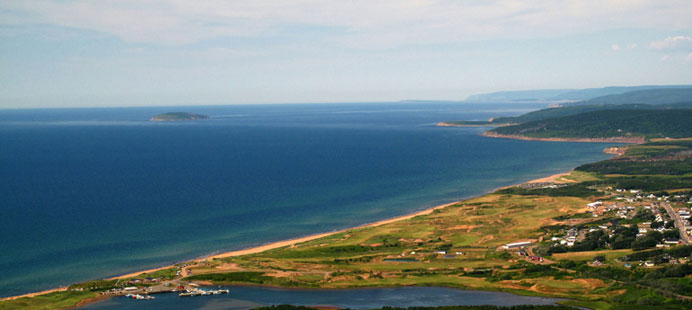
Cabot Links, where the highlands meet the sea.
When Mike Keiser started poking around for land near a large body of water in the early 1990s, his friends chided him. When he settled on a parcel along the Oregon coast, his colleagues advised against such folly. Twenty years on Keiser’s name is associated with as many world top 100 courses as any architect!
So what do you do if you share Keiser’s vision for fun golf – a game best enjoyed on sandy soil by the sea and buffeted by the wind – but don’t have the financial wherewithal to pursue your own ‘dream golf’?
This was the very dilemma facing Ben Cowan Dewar in 2005 when he entered into an agreement with the town of Inverness on Cape Breton Island to develop a golf course along 160 acres of open space sprawled between the town and the Gulf of St. Lawrence. Cowan-Dewar needed to partner with the right person, someone who shared his vision and also had the resources to bring the project to fruition. Of course, Keiser is that man with the know-how to build walking only, public courses in remote settings that attract golfers in flock. Yet getting on his calendar is no small feat. Cowan-Dewar and I met in Chicago to lay out the opportunity with Keiser who ended up agreeing to meet us in Nova Scotia the following March to inspect the property.
Alas, the charms of the site were not on full display that gray March day in 2007. So much for the light sparkling off the water, sea gulls fluttering, and people strolling along the surf! Fortunately, Keiser saw past the winter aberrations and became intrigued by the project as well as the opportunity to purchase additional coastal land two miles north. Keiser clearly appreciated Cabot’s greatest asset: The sight of the ocean from every hole coupled with rhythmic waves resonating in the background.
Central to Keiser’s enthusiasm was the support that the project enjoyed with both the town of Inverness and regional government entities. In fact, the town had off and on since 1969 pursued the notion of building a course. Architects Graham Cooke and Jack Nicklaus had done routings but financial backing never materialized. Still, the town persevered and this time support came from the government. Similar to how the Keltic Lodge and the Cape Breton Highlands Golf Course on the northeast side of Cape Breton had attracted world travelers for seven decades, both the community and all levels of government felt that Cabot would also. Appreciative of an opportunity to work in harmony with both town and government, Keiser committed to the project.
With Keiser’s participation assured, Cowan-Dewar did something that few developers ever would: He moved his family to the project site. Relocating from Toronto to Inverness was the ultimate “all-in” committal and was shared by his wife, Allie, who abandoned her career. There could be no doubting their commitment to both the town and to Keiser. While Cowan-Dewar’s eye for architecture is as sharp as anyone (he is on track to become the youngest person to play the world top 100 courses as ranked by GOLF Magazine), he was unproven as a project manager. Yet, all that know him were sure that his passion, determination and work ethic would more than compensate for any lack of experience. By all measures that has proven to be the case.
Of course, central to any successful golf venture is matching the architect to the task at hand. In addition to partnering with Keiser, the employment of Canadian Rod Whitman created another cornerstone that ultimately ensured the project’s success. Well known in golf architecture circles as being one of the best “dirt guys” in the business, Whitman’s resume features several heralded designs in western Canada, including Sagebrush, Blackhawk and his first solo effort, Wolf Creek. All are ranked among the thirty best in Canada. Whitman’s mentor was Pete Dye but he had also worked closely with his friend Bill Coore on projects in Indonesia, France and on several of Coore & Crenshaw’s highest profile courses like Friar’s Head and Old Sandwich. Unlike many golf architects whose names appear on the office shingle, Whitman immerses himself personally in each project and does a lion share of the earth moving and shaping. Ultimately, what a developer gets when he hires Whitman is ….. Whitman!
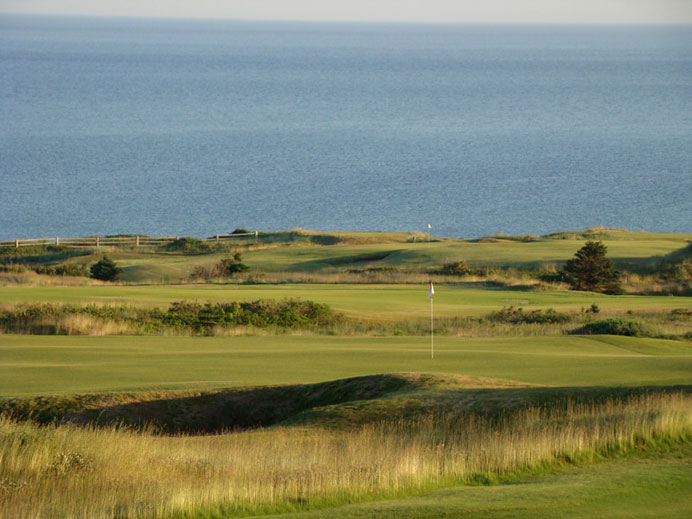
This view across the course highlights the land’s gradual descent from the town to the sea. It also demonstrates how soft Whitman’s hands were upon the ground.
Abandoned as a coal mine in the 1950s, the Cabot property is bordered by a long shoreline to the west, a working harbor southerly, and on the east by the town of Inverness. Views of the Margaree Island and of the Gillis Mountains are afforded to the north. For Whitman the canvas at Cabot represented the finest opportunity of his three decade long career and he was keen to show the world what golf insiders already knew. Following Cowan-Dewar’s lead, Whitman moved to Inverness and spent three years building the course, realizing that there were three broad objectives to meet in order to bring the best golf to this site.
First, there was the challenge of getting the golf to stand up to the dramatic coastal environment. Anyone can route holes along the sea but can the golfing quality of those holes match the setting? Seaside terrain is extremely precious and the critics’ knives would be out if the 2,600 yards of ocean frontage wasn’t utilized in a most inspiring manner.
Second, there was the necessity to have the holes that didn’t enjoy such natural blessings meld admirably with those that did. Obviously this is true with every course but here it was especially important because Cabot’s coastal holes reckoned to invite comparison with the best in the world. Indifferent inland holes would stand in marked contrast to the ocean ones and potentially devalue the entire course.
And third, there was the need to blend the remaining vestiges of the 1950s mining operation to that of a links course. Stark man-made features from the mining era needed to be softened and knitted harmoniously with the surrounding linksland.
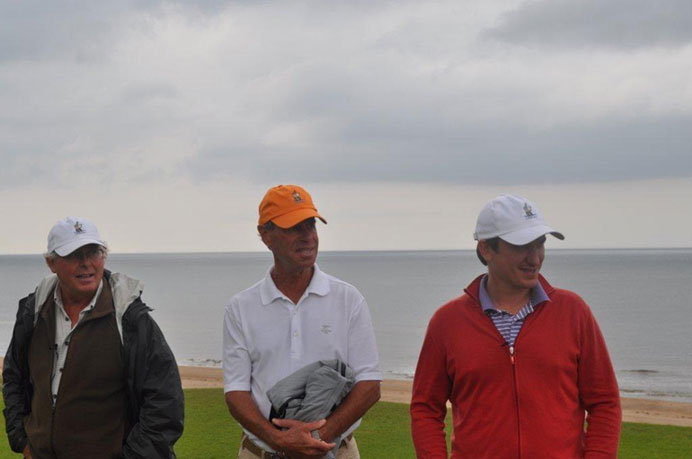
On site where it matters: Rod Whitman, Mike Keiser and Ben Cowan-Dewar.
Because of Keiser’s unflinching commitment to the project (and remember this was during the 2008 recession that gripped North America) and Cowan-Dewar and Whitman living on site, something special slowly emerged from the landscape. All eighteen holes opened for play on June 29th, 2012. The result is there for all to enjoy but it was the interactions between these three men that lead to something out of the ordinary being created.
Holes to Note
Please note: The vast majority of the photographs in the Holes to Note section are by Australian photographer David Scaletti. For more information on David’s work, please refer to his March 2008 Feature Interview.
First hole, 540/515 yards; In March 2007 when they first walked the property together, Keiser turned to Whitman and said, ‘What are you going to do here?’ The question was apropos because this and the next hole occupy the least interesting portion of the property. Whitman demurred without specifics, knowing that the answer would evolve after spending months on the property. What transpired neither man could have foreseen. During the following two springs, Keiser had Whitman and Cowan-Dewar travel to the United Kingdom in search of ideas to be incorporated into the final design. One of their very favorite courses was Prestwick and those little humps and bumps to the left of its all world par five third inspired the humps and hollows found to the left of Cabot’s gentle opener.

The depression short right retards some three wood approach shots from reaching the putting surface. Note the mounds left of the green.
Second hole, 245/220 yards; Over the past twenty years so much has been written about golf course architecture that even the casual observer knows that one measure of quality is the variety found among a course’s one shot holes. Cabot scores well in this regard as the difference between the shortest and longest one shot holes is 145 yards (i.e. a full fourteen clubs)! Depending on the day’s hole location, this 47 yard long green can require as many as five different clubs for one’s approach shot. Even playing short of the green makes sense for certain front right hole locations. Holes beyond the three foot deep trough that bisects the middle of the green are significantly more difficult to access.

Though laid upon relatively level land, the Biarritz swale and the left to right tilt of the putting surface conspire to keep the proceedings lively. Today’s back hole location is quite a bit harder than ones short of the swale.
Third hole, 330/290 yards; When a group of armchair architects toured the course with Whitman during construction, they all exclaimed the same thing when they reached this future tee: Ten at Riviera! Here was an elevated tee to a straightaway fairway and a green site angled 45 degrees to the fairway. Under certain wind conditions the hole would be drivable. The excited party busily chatted about this bunker and that à la Riviera. Whitman smiled, understanding the concept yet visualizing something altogether fresh and different. His long-time friend Dave Axland helped bring it to fruition. Unusual for a drivable par four, the fairway is huge and there isn’t a single bunker. This is in stark contrast to the other short par four, hole nine, which is the most heavily bunkered hole.
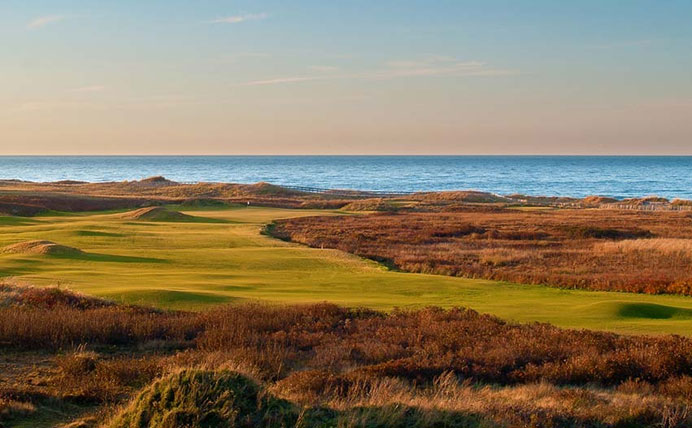
While the holes adjacent to the beach and along the harbor soak up much attention, this is a gem and one of Cabot’s very best, an instant classic of strategic design.
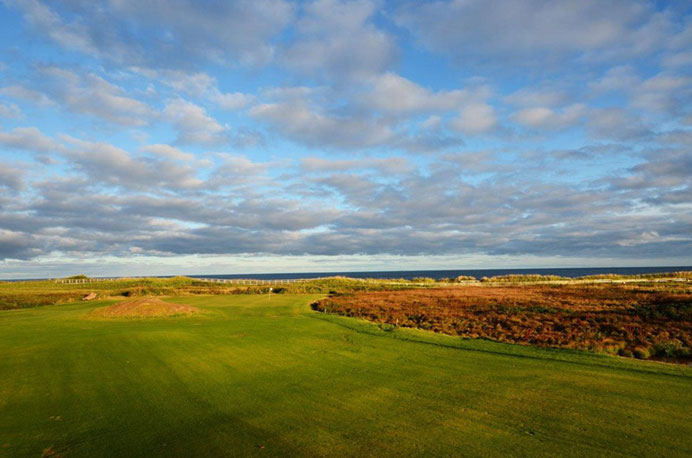
The wide fairway (60 yards) and a lack of bunkers can confuse the golfer looking for guidance. Perhaps he should lay back with a utility club or three wood? Maybe a driver is the correct play that day? Such nagging doubts and indecision often precipitate poor swings from the tee. The prevailing left to right breeze toward the wetland doesn’t help either.
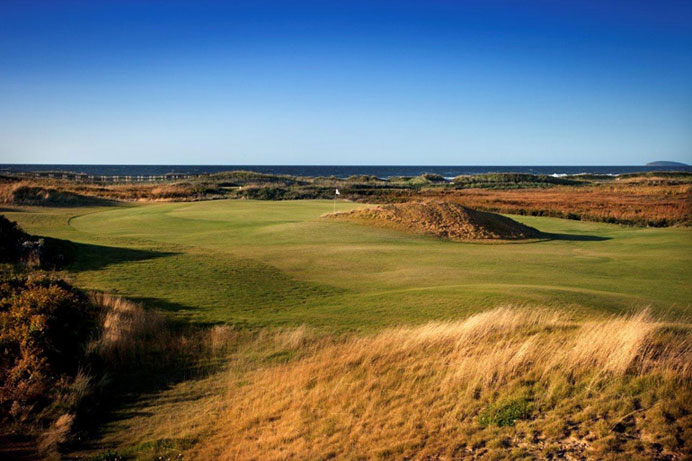
Most tigers who give the green a go favor the safer left side away from the wetlands. However, that leaves a ticklish pitch over this mound to any forward hole location.
Fourth hole, 450/405 yards; This is the only hole on the course that plays directly away from the water. As such, it climbs gradually uphill and finishes at a green sitting near the base of town. Whitman always (somewhat mysteriously) considered this among his personal favorites. He explained: ‘The gradual upslope and a plateau that was very suitable for a green were two fine natural features. The upslope helped me create some of the most intimidating bunkers on the course and the natural plateau lent itself to some of the boldest green contours. This hole was always going to be a winner as it had such good things going in its favor.’ This is hardly true at other courses where holes lead away from water. Royal Portrush with its awkward fifteenth and Pebble Beach’s uninspired eleventh are but two examples of major letdowns during the transition from coastal to interior holes.
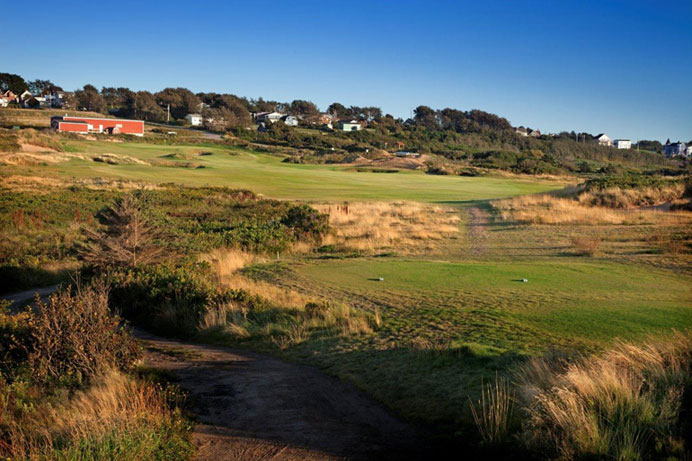
The uphill fourth and the Cape sixth are two of the longest par fours on the course. Similar in length, Whitman takes pride that the two holes are routed in opposite directions so that they will each play quite differently from their yardages in a typical breeze.

The deepest fairway bunkers are found at the fourth and cost the golfer a 1/2 stroke in a similar manner to the pot bunkers found at famous links across the United Kingdom.
Fifth hole, 180/170 yards; The task of any architect is to take the player on a tour of the property and to highlight its best attributes. Different in character, this pocket of land is sandwiched between a hillside left and the harbor right. Aside MacIsaac’s Pond the stunted vegetation associated with a links is replaced with greener, lush plants like Labrador tea and bayberry that rustle in the wind.

Whitman cites the fifth as an example of a hole that improved during the patient, measured design process. Originally, he saw the green being lower and to the left.
Sixth hole, 465/ 435 yards; Cabot’s 6,805 yards from the back markers are not excessive but remember that par is a tight 70. As usual, the best markers from which to play are well forward for most and that is especially true here. This 80 degree dogleg left begs the brave golfer to cut the corner. Played from a forward tee, the carry becomes reasonable and the golfer puts himself in prime position for one of the most inviting approach shots anywhere.

As a true Cape, the same water hazard threatens both the tee ball and the approach. The fairway is straight ahead but the flag well to the left becomes a dangerous siren. Greedy tactics off the tee can lead to trouble or reward the heroic player with a short iron approach.
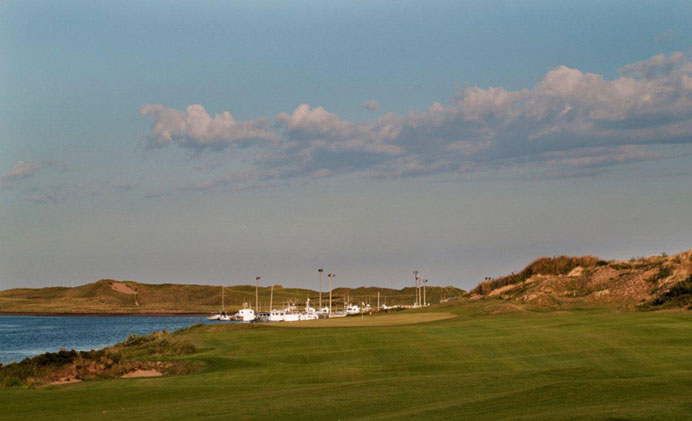
Where there are boats, there is wind. Flighting a ball low through the wind from a sloping fairway to a green open in front constitutes one of the most engaging shots in the game. In this case, it is made all the more picturesque by the working harbour in the background. Utilizing the broad slopes that feed off of the hillside on the right certainly makes sense as there is no reason to flirt with the hazard left.
Seventh holes, 190/155 yards; Want to understand Keiser’s commitment to surpassing the recreational golfer’s expectations? Look at the evolution of this hole. When construction began, this small seven acre triangle was in use, providing ice for the local fishermen at the working harbor. Later the opportunity to acquire this plot became available and was seized upon. Though Whitman had already built a par three, Keiser instructed him to build another on the newly acquired land. The result is an improvement as the new hole better capitalizes on the seaside setting. Though the old seventh was in use for only eight months, several gentlemen had scored hole-in-ones. Imagine their return next season and the discovery that the site of their conquest is gone!
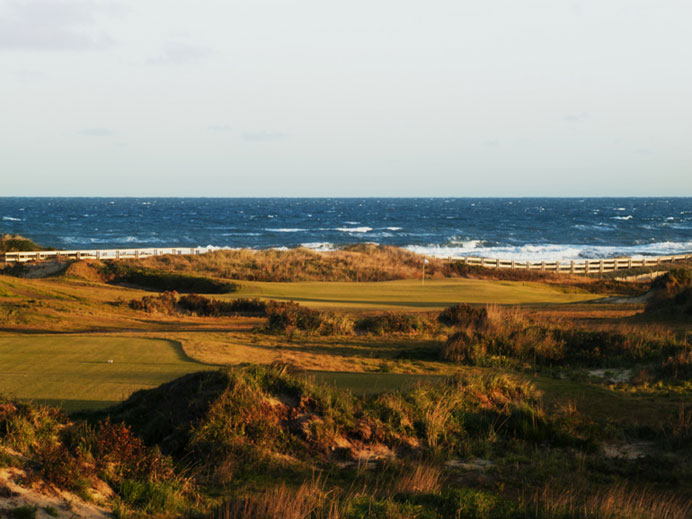
The new seventh is better knit to the oceanside setting than its predecessor. Only sixteen paces in width, its green comprises the smallest target at Cabot.
Eighth hole, 580/515 yards; The wetlands dominate this low section of the property and played a key role in the routing process. One thing Whitman wanted to avoid was a forced carry approach shot in a windy location. Thus, he mulled over various ways to incorporate the wetlands other than as a fronting hazard for a green. He succeeded here by giving the golfer a perfect lie from the tee to make such a carry. Similar to the drive on second hole, the key objective is to get in a position to carry a ridge on one’s second. When played downwind, the Double Green is often in reach. The innumerable contours within the massive green create great flexibility. Hole locations found in an attractive gathering bowel front left can be readily accessed while those top back are much more challenging. The green’s random contours look like the wind shaped them but in truth it was Whitman’s protracted efforts over a full month that slowly developed them.
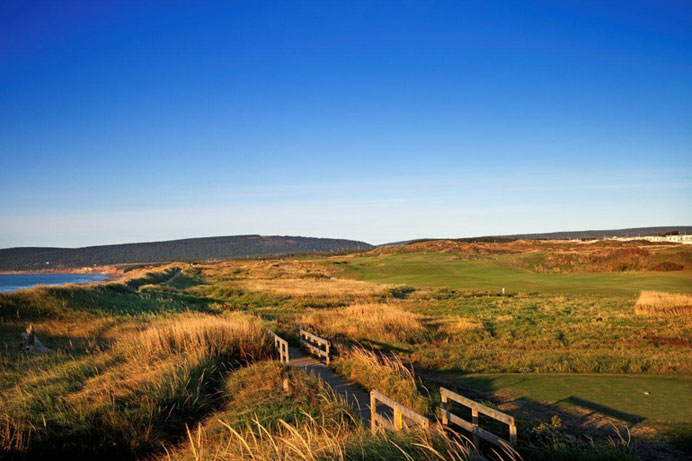
To the left is a boardwalk that wanders the length of the hole. To the right are wetlands, part of the diversity of hazards that confront the golfer at Cabot.
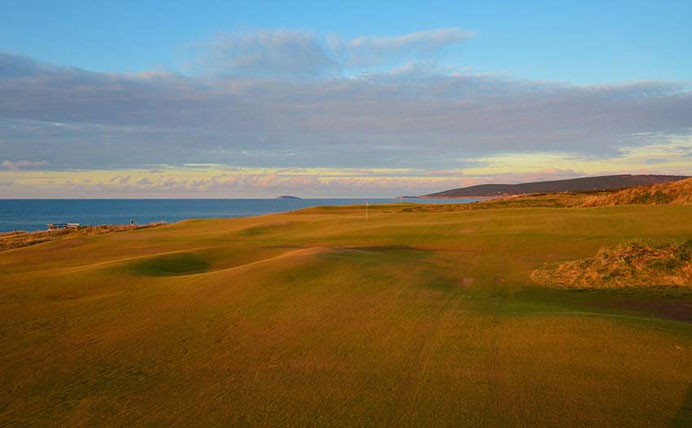
According to Whitman, one of the tenets of good design is to first pick out the ‘must keep’ green sites. This one, the fifteenth and sixteenth are among those that he found and incorporated into the final design.
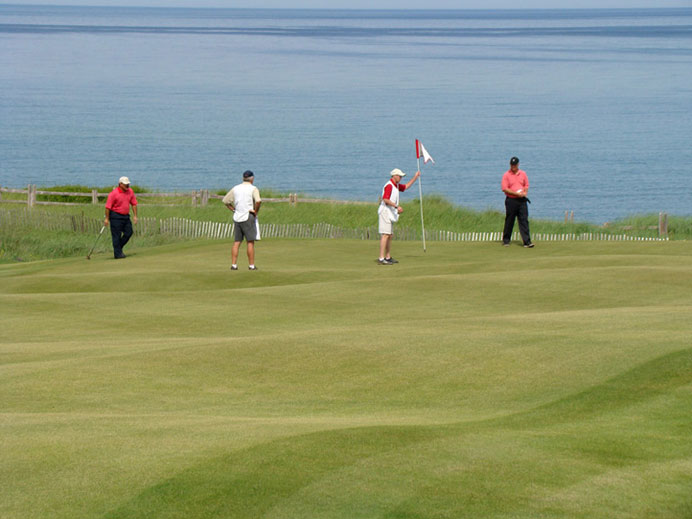
The numerous dips and swales throughout the Double Green may remind the golfer of the famous putting surfaces at St. Andrews.
Ninth hole, 360/320 yards; The absence of central hazards is one of the great crimes of the Dark Ages of design (loosely defined as the period between 1950 and 1985). Simply put, architects rarely employed them and instead blandly placed hazards to the sides of fairways voiding all options. Disregarded were the timeless lessons learned from The Old Course at St. Andrews where numerous bunkers are surrounded by fairway grass. The Golden Age architects were wiser. Beginning with the two bunkers placed in the left center of Woking’s fourth fairway, central hazards were created by man to lend holes strategic interest. At Woking, the mere existence of the two bunkers necessitates a decision by the golfer but it is the front left greenside bunker combined with the right tilt of the green that makes the hole nothing short of brilliant. So is it at the fifth, where two dominant central hazards work in perfect concert with the green contours.
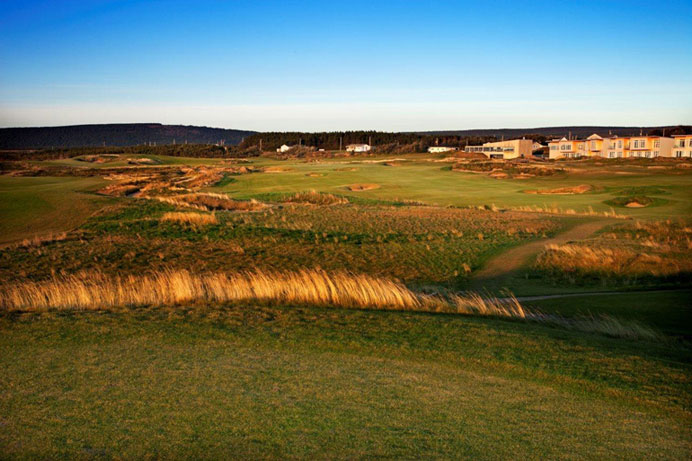
At the ninth the wind determines which of the two central hazards forty-five yard apart is in play that day.
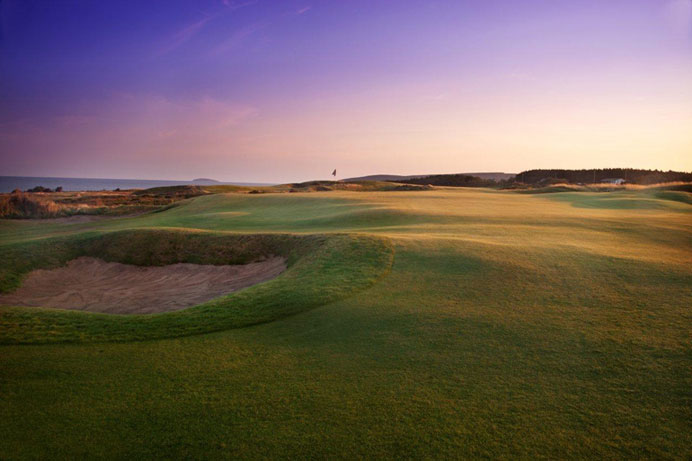
The green angles from right to left and a wicked false front feeds balls short left. If the hole is located forward the good player must control the ball’s spin or he may face a fifteen yard chip back up the hill after repairing his pitch mark on the green. The niftily placed front left bunker is a fooler as it is a full seven paces from the front of the green. It not only hides the green’s false front but visually tricks the golfer into coming up short on the uphill approach.
Tenth hole, 385/325 yards; Few better vistas exist to start a second nine than here as the fairway heads straight toward the water on this gentle dogleg to the right. It is an old fashion position hole, both for the tee ball and approach. Golfers these days tend to try and overpower courses as opposed to playing shots; rash tactics here can lead to a surprising range in scores. The angled green falls toward the back left away from the golfer and judging where to land your approach is a shot that never grows old.
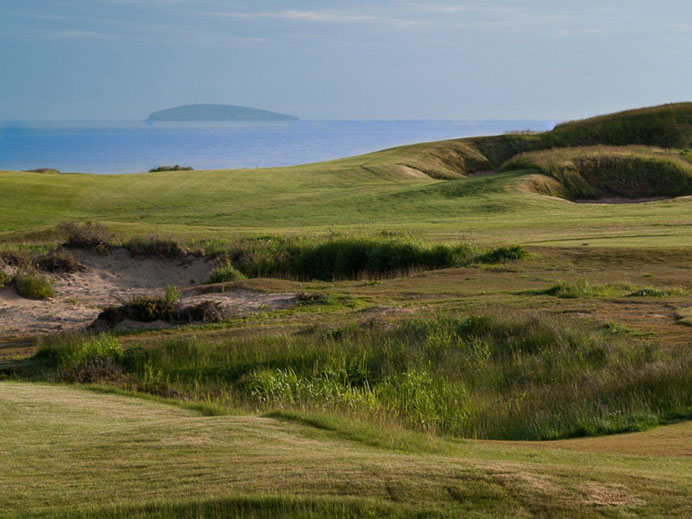
This is the thrilling view from the tenth tee. A fade played off the distant Margaree Island is ideal.
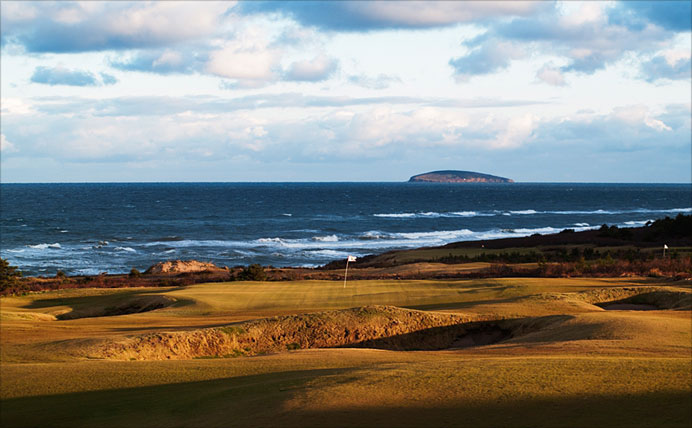
Following the natural contour, the tenth green slopes from front right to back left. The two forward bunkers are situated well away from the putting surface and cloud the golfer’s judgment of where to land his approach.
Eleventh hole, 620/490 yards; Reminiscent of the fourth at Bethpage Black and the sixth at Pebble Beach, the tee ball must be placed far enough down the fairway so that one’s second shot can climb onto the plateau that begins some 130 yards short of the green. Failing to surmount the precipice necessitates a blind approach to a green fiercely defended along its right by a deep depression. Similar to his friend Bill Coore at Kapalua, Whitman helps golfers of all levels by expanding the ground away from trouble, creating lots of fairway that sweeps left around the depression before ultimately feeding seamlessly onto the putting surface. The fescue fairways release low chasing shots perfectly, allowing the emphasis that Whitman puts on the ground game to be fully realized. Skeptics of building a course that is only open from late April to early November miss the point of Cape Breton’s superior climate of low humidity and cool evening temperatures that yield ideal conditions for grasses conducive to good golf (i.e. weather more akin to that in the United Kingdom than the lower two thirds of North America). Without such playing conditions, a hole like the eleventh would merely photograph great. As it is, Cabot plays as well as it photographs with balls gleefully bounding along the tight fescue turf.

The eleventh, one of Keiser’s favorites, works well in part because of the acres of short grass that balances out the terrors on the right. At 75 yards in width, the fairway is one of the broadest on the course and accounts for some of the 60 acres (!) of short grass that is maintained. The real challenge is up ahead where the golfer needs to carry the ridge on his second in order to…
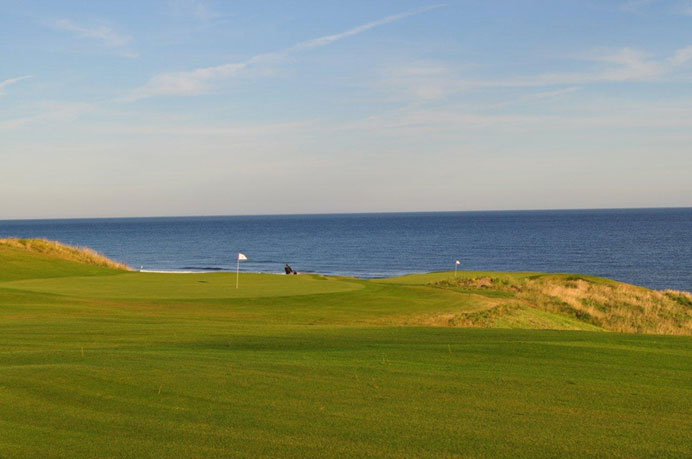
…enjoy this view for his third. If the golfer can get to this position in two, the pitch from ninety yards might set up a birdie.
Twelfth hole, 450/410 yards; The property at Cabot is rectangular with its long side running along the Gulf of St. Lawrence. Hence, it was a given that a majority of the playing corridors would flow along this north/south coastal axis. Early in the routing process Whitman found the wide valley running north/south in which the third fairway now meanders. Sandwiched between the dramatic eleventh and thirteenth holes, Whitman kept this hole’s appearance ‘quiet’ yet it is one of the toughest pars on the course.
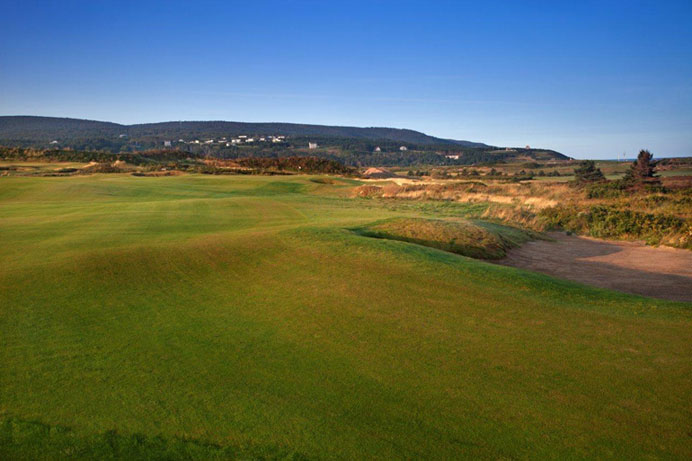
After avoiding one of the largest fairway bunkers off the tee, the golfer faces an approach to a green that Whitman benched into the hillside. The wind is less in play down here than on the holes played higher on the bluff.
Thirteenth, 440/405 yards; Whitman’s masterful routing and wonderful tee placements provide a series of attractive views down many of the fairways. His tees are often positioned on natural high spots in stark contrast to other modern architects who build up enormous tee pads that are unnatural and jarring to the eye. The only tee shots at Cabot that climb are here and at the eighteenth. Generally played downwind, a well-struck tee ball soars past three sleepered bunkers cut into the far ridge, providing a most delightful (and welcome!) sight. On top, one of the great views at Cabot unfolds with the Gulf as the backdrop to the massive 27,600 square foot Double Green. This technically qualifies as an inland hole and is a shining example of one being as memorable and providing as much fun golf as a coastal hole.

Though played uphill to a blind fairway, the tee shot at the thirteenth is one of the most attractive on the course. It is also the most austere!
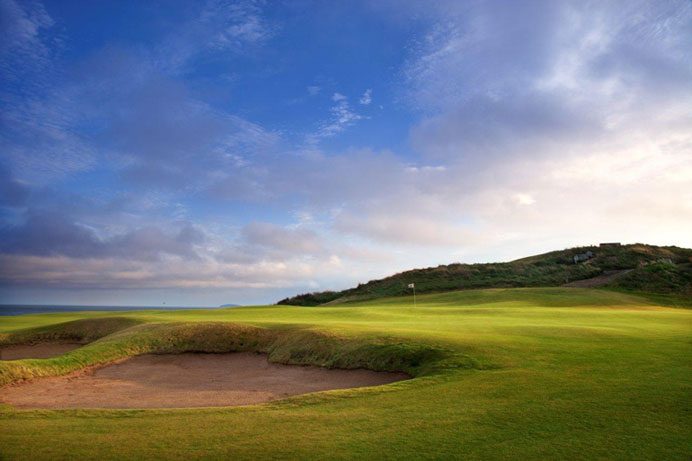
The approach shot is thrilling in any wind because the architect didn’t dictate how it must be played. With bunkers left and all of Cape Breton Island to the right, the golfer is offered numerous choices to come at this honker of a green. The firm running fescue fairways guarantee that all shot options are available.

As seen from behind, the golfer gains a perspective as to the Double Green’s orientation to the fairway. When played downwind, the golfer may well decide to play a draw that lands 10 or even 20 yards short and to the right of green and let the contours feed the ball well into the Double Green.
Fourteenth hole, 100/90 yards; In 1984, Herbert Warren Wind wrote a compelling article about Merion, Seminole and Cypress Point in which he extolled the virtues of designs that require both strength and finesse. At that time many of the household name courses placed emphasis solely on length and Wind felt that something was missing. Right he was! Happily, Cabot presents a beguiling array of delicate shots. Be it the front to back greens, the rambunctious Double Green, the ticklish wedge into the ninth, the drivable par four third or the short pitch here, the golfer is guaranteed a slew of fiddly little shots with which to contend. Though the green seems ample at 5,240 square feet, it plays smaller, sloping off both to the left and right. Throw in cross winds and the effective target shrinks all the more!

As seen by these three photographs, the character of this tiny one shotter changes dramatically with the weather.

Similar to the seventh at Pebble Beach, the elevated tee offers no place to hide from the wind and pandemonium ensues with a cross wind like today’s.
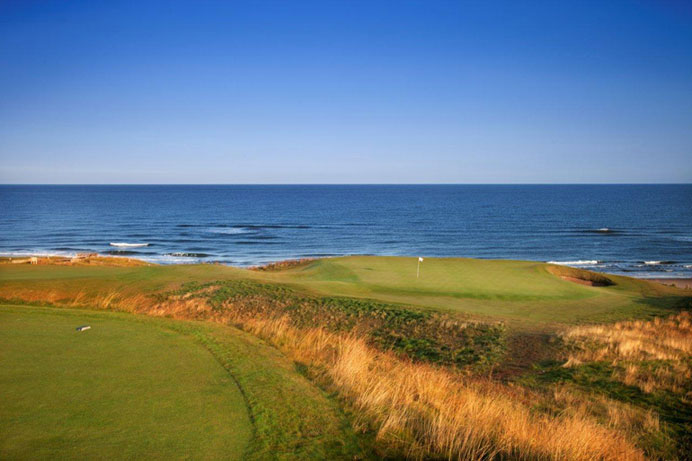
Note how the clean backdrop and low profile features allow the green’s fortuitous position to speak for itself. Whitman knew better than to add anything that would distract the eye from nature’s glory. He considered a bunker left but concluded that such a man-made contrivance would only clutter the hole. What’s not shown is how merciful the right bunker can be, providing an easier recovery than the worse positions where the short grass may deposit a ball.
Fifteenth hole, 415/380 yards; Coastlines tend to be straight or jagged. At Cabot Links, it is sand based and therefore linear. In contrast, Cabot Cliffs features rocky cliffs with fingers of land that come in and out of the water. Bill Coore, the architect for Cabot Cliffs, has routed holes there that take advantage of the angles created by the irregular shoreline. Whitman didn’t have the same luxury but by a stroke of genius was able to give this straightaway hole interesting playing angles. The clever design rewards the golfer playing boldly left down the coastline where he will enjoy the most favorable approach, especially when the hole is back right. Cranberry, creeping juniper, marram grass, fescues, alders and wild rose permeate the greenside area with a vibrant texture.

As seen from the tee, there is lots of fairway well out to the right. Yet steer too cautiously that way and the angle of approach created by the inverted L shaped green and solitary right greenside bunker will progressively work against the golfer.
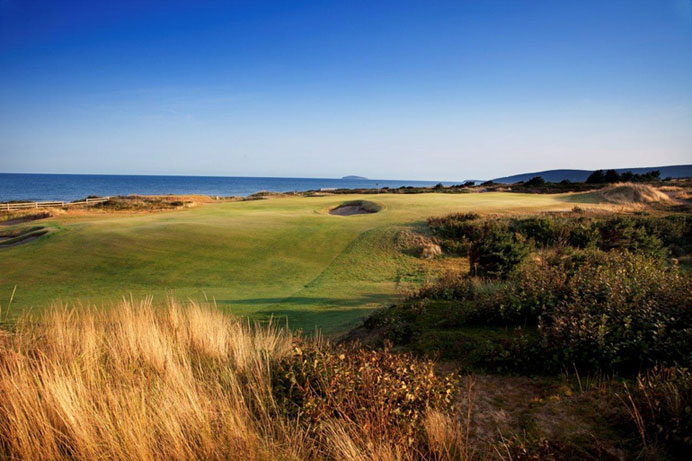
Most golf architects’ proclamation that they ‘follow nature’s lead’ is nothing but blarney. In this case, it is valid though. On one of Whitman’s initial walks, he noticed how the clover and ground vegetation grew in an upside down L configuration atop this natural plateau. Whitman liked what he saw and built the bunkers and green with that pattern in mind.
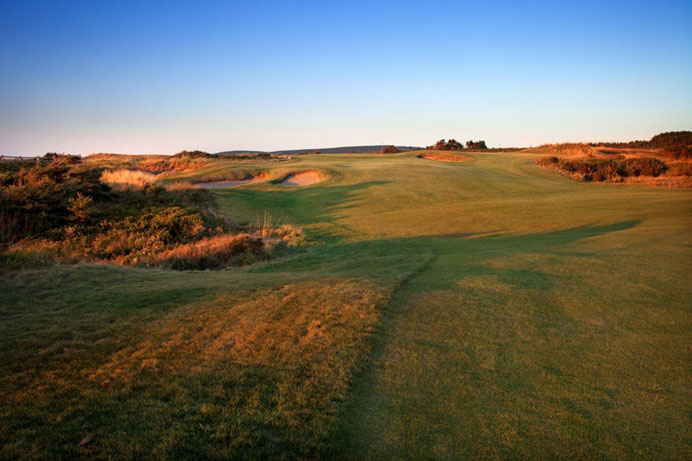
The bunkers flow naturally into the green configuration with the solitary right bunker occupying an especially confounding position.
Sixteenth hole, 455/390 yards; What’s there to say? Few courses offer such a magical moment. The hole plays as great as it looks due to Whitman’s masterfully lowering of the right side of the fairway so that it became well suited for golf. The resulting humpy bumpy fairway appears untouched by man and for Whitman that means mission accomplished. This is nature’s show where the exquisite confluence of land and sea create an indelible impression on every golfer.

At the highest level, golf takes people to some of the prettiest spots in the world. This is one such instance.
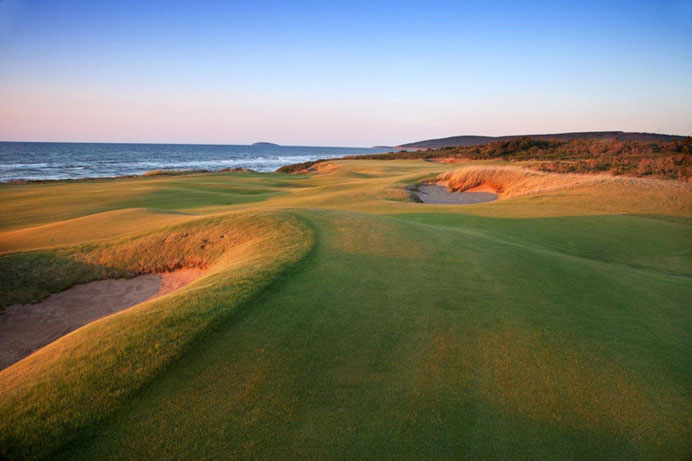
Like all true links, central hazards dot the fairway and there is a great chance that adjustments will need to be made in one’s stance to accommodate uneven fairway lies. Those that hug the side where more trouble exists (i.e. the cliffs left) are rewarded with a more level stance.

It is one of a kind moments like this that reward the golfer for making the trip to Cabot.
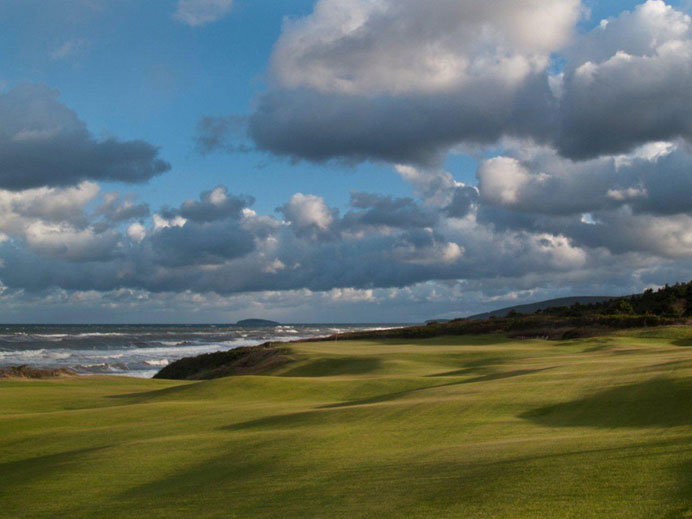
A gully short left feeds shots toward the beach so the smart golfer aims at the right edge of the green and plays a draw to utilize the right to left slopes. As the green is much wider than deep, balls should be rolling along the ground prior to reaching the green.
Seventeenth hole, 170/130 yards; Among the best design features at Cabot is the way many of the greens are subtlety angled to the line of play. In this instance, the green projects from its swollen front right to a narrow pocket back left. Pay particular note when the hole is far back left where there is a clever little bowl that gathers balls from both sides. A hole in one is possible but you need to select one more club than usual and commit to that line to reach this opportunistic back hole location. Similar to the seventeenth at Pebble, if you fail and push it right, recovery becomes improbable.
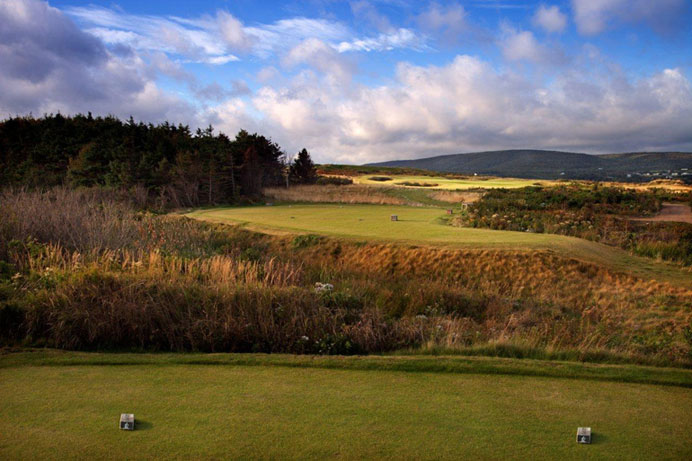
Just as he did at the uphill ninth, Whitman used the natural slope of the land to create some of the course’s most attractive bunkers as well as one of the most fiercely sloped back to front greens on the course.
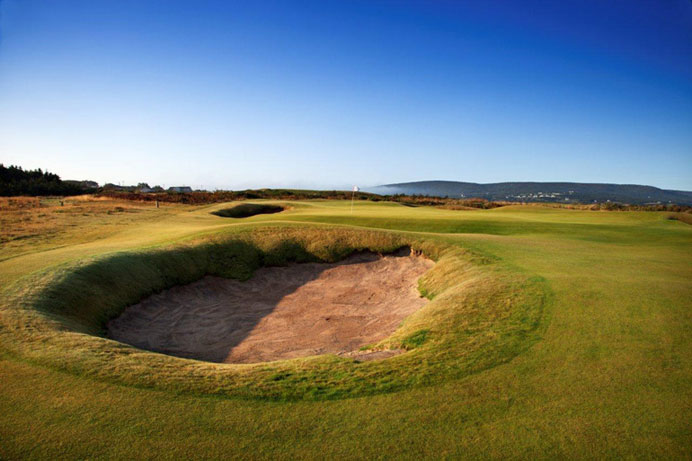
Note how a front bunker is again pulled well away from the putting surface creating depth perception issues.
Eighteenth hole, 475/390 yards; Depending on the wind, either the Stella Maris Parish spires or the edge of the clubhouse serves as the ideal target for this blind drive over a ridge. Beyond there is a down slope that the golfer dearly wants to take advantage of to shorten his approach. For those unfamiliar with the great links of the United Kingdom, the close proximity of the clubhouse to the green might be disconcerting. Just as it is at Royal Troon, Royal Lytham & St Annes and Prestwick the golfer here in full command of his game relishes an opportunity to showcase his skills to onlookers. For those less sure, a dip in the fairway some thirty yards short of the green offers a viable option to propel the ball on or near the green and avoid the perils either side of the putting surface.
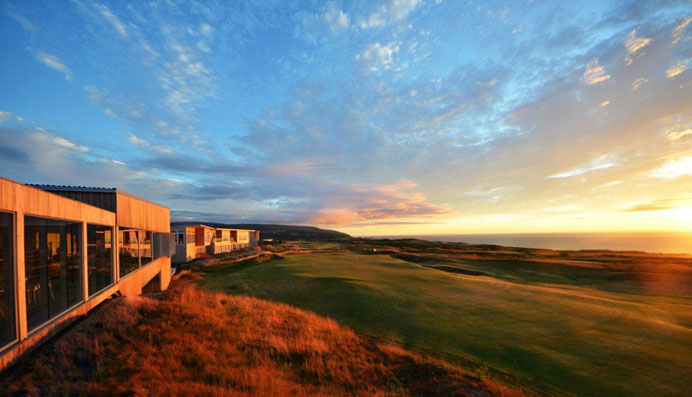
The clubhouse, its porches and glass windows afford numerous vantage points. Do all the eyeballs and the clubhouse’s proximity inspire or unsettle the golfer? Both the player and the spectator will soon know the answer!
Keiser, Cowan-Dewar and Whitman never worked together prior to Cabot Links. As they gained familiarity, the final design got better and better. There are numerous examples. Keiser’s frequent site visits led to the introduction of ideas like the Double Green and the Biarritz swale. Such time proven design features are meaningless unless the right person successfully translates them in the dirt – and there is no person better than Whitman in that regard. Keiser’s urgings that Cowan-Dewar and Whitman twice travel to the United Kingdom inspired the sleepered bunker faces at the fourth, the humps and bumps left of the first green, several of the blind drives, and a general agreement as to how the bunkers at Cabot would be presented.
Cowan-Dewar shares Keiser’s vision of golf and wherever there was room to give the recreational golfer a bit more he made it happen: Streamlining the view behind the first so that the Gulf was all the more present, pushing the eleventh green as far right as possible for the sake of a more attractive backdrop, insuring that the walking paths were well routed yet unobtrusive, etc. As Whitman and Cowan-Dewar lived on site there wasn’t a detail too small or overlooked.
A Keiser project is never rushed and the more time Whitman spent on site, the more nuanced the course became. Whitman only half joked when he said ‘The ideal is to go as slow as possible without getting fired’ and the results of his prolonged work in the dirt validate those sentiments. A few weeks after the course opened, Whitman summed it up nicely when he noted ‘I feel like I was part of a Stanley Cup team. Building courses isn’t an individual effort and it takes a lot of the right people making the right decisions every step of the way. That’s what happened here and I was fortunate to have been a member of the team.’
Such synergy only occasionally occurs. It helped enormously that all three parties agreed at the onset that the golf came first. This wasn’t a housing project nor would paved golf cart paths mar the landscape. If something could be done to improve the golf experience (e.g. burying phone lines, building a berm to hide a road, securing the property around the course), it was. Keiser knows that the recreational golfer can be extremely loyal and appreciative to those that create ‘dream golf.’
The odyssey began with the town of Inverness making a bet that Cowan-Dewar could develop a course of which it would be proud. That trust in him has been handsomely rewarded with one of the world’s great golfing venues now in their backyard. Whether Coore & Crenshaw will match the design success of Cabot Links at the cliffs site remains to be seen but it is certainly a most welcome subject to debate.

Played mostly well above the Gulf on a cliff line, Cabot Cliffs will enjoy its own personality.
People have long come to this lovely part of the world to take in the Gaelic culture, attend a folk dance at a local pub, sample scotch at the Glenora Distillery, enjoy the day’s catch from the Inverness harbor and/or drive along the world famous Cabot Trail. Cabot Links and soon Cabot Cliffs offer additional compelling reasons to venture to “New Scotland” as they bring the greatest game in its purest form closer to home for North Americans than dear old Scotland.
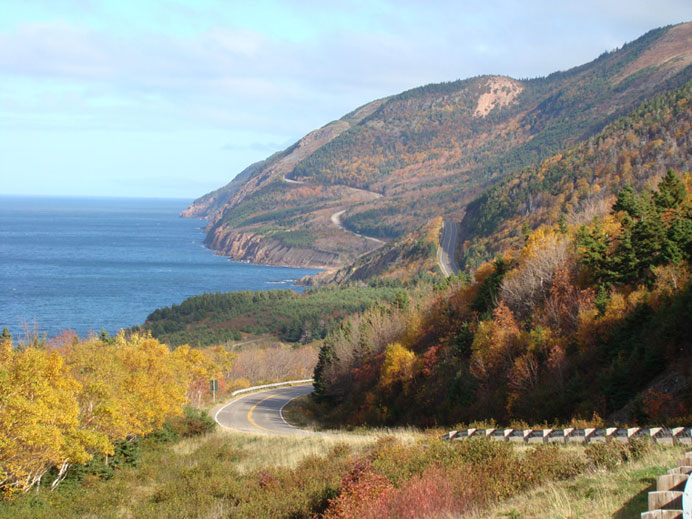
The Cabot Trail loops around the northern tip of Cape Breton Island. Conveniently, it leads from Cabot to Stanley Thompson’s masterpiece at Cape Breton Highlands.
The End


